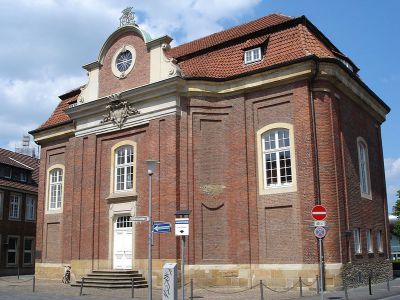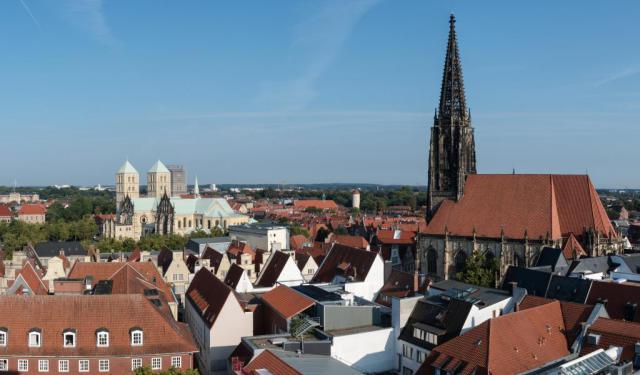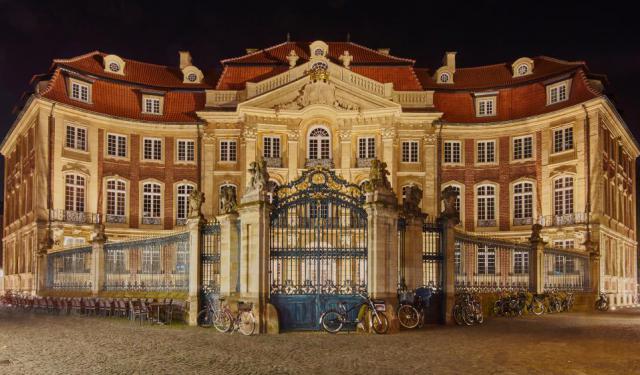
Lotharinger Chorfrauenkirche, Munster
The Lotharinger Chorfrauenkirche is a former choral church of the Lotharinger Kloster (Lorraine Women's Cloister) in Münster. The history of the sanctuary began in 1642 when a group of choir women from Lorraine (German: Lothringen) province came to Münster as refugees and established here a convent to devote themselves to the support and education of young women and girls.
The first church on the site, built in 1698, was destroyed, along with the rest of the convent, by shelling during the Seven Years' War, in 1759. The new complex, including the current church, was built from 1764 to 1773. The church's interior decoration was completed in 1775.
Both the convent building and the church were the last work of the renowned German architect, Johann Conrad Schlaun. His daughter was admitted to the convent as a choir lady, and his nephew, Lieutenant Colonel Johann Anton Josef von Thelen, oversaw the construction management.
Designed in Baroque style, the brick building has a square plan with rounded corners. The coat of arms over the front portal belongs to the nobleman who funded the construction.
The building acted as a place of worship until the dissolution of the convent in 1811, during the French occupation. After the territory was reclaimed by Prussia, the building was sold to the city of Münster and subsequently served a number of secular purposes, such as barracks (until 1931), apartment block (until 1955), and the city archives (from 1978 to 2003).
While most of the convent buildings burned down during World War II and had to be demolished, the church itself survived almost intact. From 1961 to 1973, it had been renovated and its facade reconstructed based on a copy of the picture from 1772.
Presently, the building houses the Marriage Registry Office.
The first church on the site, built in 1698, was destroyed, along with the rest of the convent, by shelling during the Seven Years' War, in 1759. The new complex, including the current church, was built from 1764 to 1773. The church's interior decoration was completed in 1775.
Both the convent building and the church were the last work of the renowned German architect, Johann Conrad Schlaun. His daughter was admitted to the convent as a choir lady, and his nephew, Lieutenant Colonel Johann Anton Josef von Thelen, oversaw the construction management.
Designed in Baroque style, the brick building has a square plan with rounded corners. The coat of arms over the front portal belongs to the nobleman who funded the construction.
The building acted as a place of worship until the dissolution of the convent in 1811, during the French occupation. After the territory was reclaimed by Prussia, the building was sold to the city of Münster and subsequently served a number of secular purposes, such as barracks (until 1931), apartment block (until 1955), and the city archives (from 1978 to 2003).
While most of the convent buildings burned down during World War II and had to be demolished, the church itself survived almost intact. From 1961 to 1973, it had been renovated and its facade reconstructed based on a copy of the picture from 1772.
Presently, the building houses the Marriage Registry Office.
Want to visit this sight? Check out these Self-Guided Walking Tours in Munster. Alternatively, you can download the mobile app "GPSmyCity: Walks in 1K+ Cities" from Apple App Store or Google Play Store. The app turns your mobile device to a personal tour guide and it works offline, so no data plan is needed when traveling abroad.
Lotharinger Chorfrauenkirche on Map
Sight Name: Lotharinger Chorfrauenkirche
Sight Location: Munster, Germany (See walking tours in Munster)
Sight Type: Attraction/Landmark
Guide(s) Containing This Sight:
Sight Location: Munster, Germany (See walking tours in Munster)
Sight Type: Attraction/Landmark
Guide(s) Containing This Sight:
Walking Tours in Munster, Germany
Create Your Own Walk in Munster
Creating your own self-guided walk in Munster is easy and fun. Choose the city attractions that you want to see and a walk route map will be created just for you. You can even set your hotel as the start point of the walk.
Munster Introduction Walking Tour
The picturesque city of Münster is in Westphalia, the northwestern region of Germany. It resides along the river Aa and is situated not far from the Netherlands border. Munster's roots date back to A.D. 793, when Ludger, a Frisian missionary, was sent to the region by Charlemagne to evangelize the Saxons and found a monastery. Known as the founder of Münster, Ludger later became the... view more
Tour Duration: 2 Hour(s)
Travel Distance: 2.3 Km or 1.4 Miles
Tour Duration: 2 Hour(s)
Travel Distance: 2.3 Km or 1.4 Miles
Munster's Historical Buildings Walking Tour
The centuries-long history of Munster, set in stone, is still very much alive. The carefully restored ancient homes, churches, and other – sometimes peculiar – pieces of architecture, abounding the city, “tell” the tales of its past rather eloquently, all the while setting a stage that makes every visit to Munster an exciting experience.
The reconstruction of the local Old Town,... view more
Tour Duration: 2 Hour(s)
Travel Distance: 2.8 Km or 1.7 Miles
The reconstruction of the local Old Town,... view more
Tour Duration: 2 Hour(s)
Travel Distance: 2.8 Km or 1.7 Miles
Munster's Religious Buildings Tour
Munster, a German city steeped in history and religious significance, boasts a myriad of places of worship that have withstood the test of time. Concentrated in the Old Town, they showcase the diversity of styles fit to impress anyone interested in religious architecture.
One of the most notable landmarks is the Munster Cathedral. Also known as Saint Paulus Dom, it has retained much of its... view more
Tour Duration: 2 Hour(s)
Travel Distance: 2.5 Km or 1.6 Miles
One of the most notable landmarks is the Munster Cathedral. Also known as Saint Paulus Dom, it has retained much of its... view more
Tour Duration: 2 Hour(s)
Travel Distance: 2.5 Km or 1.6 Miles



